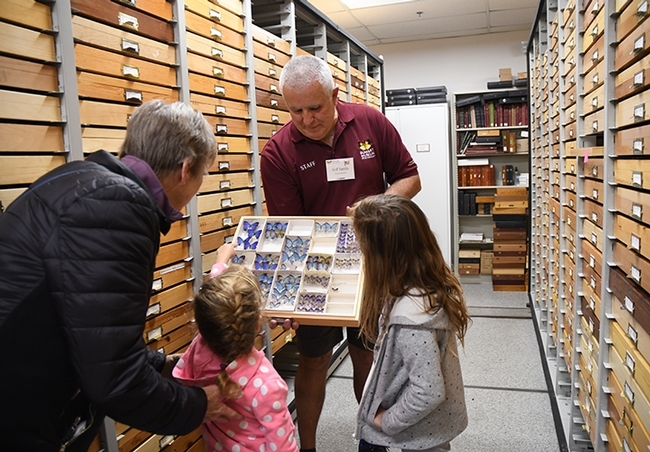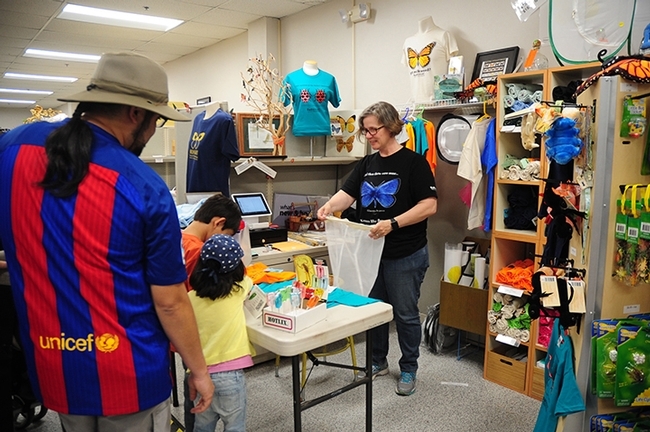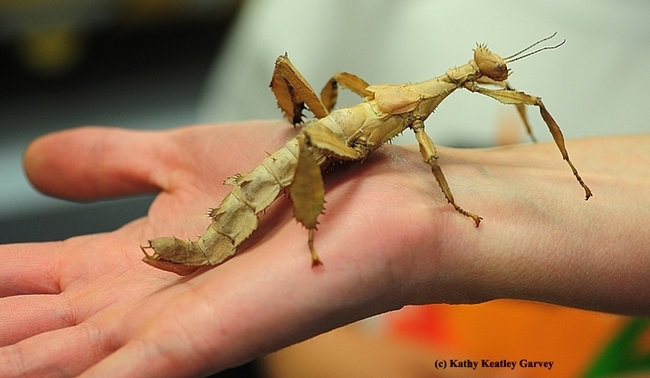- Author: Kathy Keatley Garvey
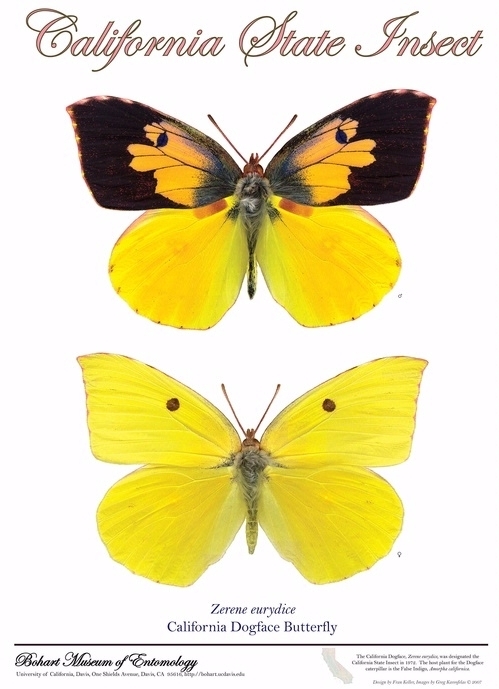
Did you know that California has a state insect? It does.
Is it the honey bee? No.
Is it the lady beetle (ladybug)? No.
Bumble bee? No.
It's the California dogface butterfly (Zerene eurydice), an insect found only in California.
The state Legislature designated it as the state insect in 1972. The butterfly is nicknamed "dogface" in reference to the silhouette of what resembles a poodle head on the wings of the male. The female is mostly solid yellow except for a single black spot on its upper wings.
Most people have never seen it in the wild. But if you've visited the Bohart Museum of Entomology at UC Davis, home of a global collection of 8 million insect specimens, you know that its logo is the California dogface butterfly.
And on Thursday, Aug. 8 those attending the Vacaville Museum Guild's Annual Children's Party (sold out) will see specimens from the Bohart Museum, as well as macro images of the butterfly, the work of talented Bohart associate Greg Kareofelas of Davis.
Tabatha Yang, education and outreach coordinator of the Bohart, has donated a drawer of the specimens for visitors to see. They can also pose in a cutout of the Bohart Museum's California dogface butterfly banner. And thumb through a 35-page children's book, "The Story of the Dogface Butterfly," written by UC Davis doctoral alumna Fran Keller, a professor at Folsom Lake College and a Bohart Museum research scientist. The book includes images by Kareofelas and Keller. Laine Bauer, then a UC Davis student, contributed the illustrations.
The book, published in 2013, tells the untold story of the California dogface butterfly, and how schoolchildren became involved in convincing the State Legislature to select the colorful butterfly as the state insect. Fourth grade students of Betty Harding and Shirley Klein, Dailey Elementary School, Fresno, advocated it as the state insect. The teachers and students enlisted the help of State Assemblyman Kenneth L. Maddy, who authored AB 1834. On July 28, 1972, Governor Ronald Reagan signed the bill into law, designating the California dogface butterfly the official "State Insect of California." (Read more on how the butterfly became the state insect under the Ronald Reagan administration.)
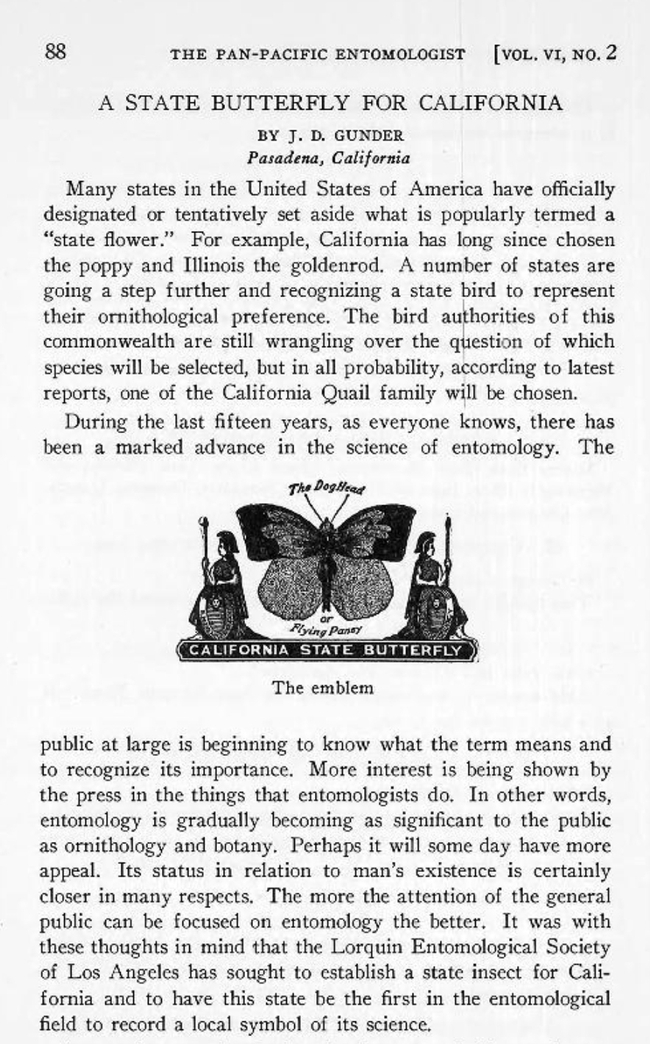
The most prevalent habitat of the California dogface butterfly is the 40-acre Shutamul Bear River Preserve near Auburn, on a Placer Land Trust conservation site; Kareofelas serves as a docent on the Placer Land Trust tours. (See virtual tour on YouTube). The butterfly is there because its larval host plant, false indigo (Amorpha californica), is there.
Are there dogface butterflies in Vacaville? Yes. The butterfly's breeding grounds include Gates Canyon. (See UC Davis emeritus professor Art Shapiro's website.)
As mentioned, few people see the butterfly in the wild. However, its image graces a first-class U.S. stamp and California driver licenses. It's also depicted on the California State Fair monorail.
Butterfly Poster and Book. The Vacaville Museum Guild's Children's Party (see what's on tap) also will spotlight a Bohart Museum poster by Kareofelas-Keller that depicts the male and female butterfly. (Both the poster and the book are available for sale in the Bohart gift shop; net proceeds benefit the insect museum's education, outreach and research programs.)
The Bohart Museum, located in Room 1124 of the Academic Surge Building, 455 Crocker Lane, also houses a petting zoo (featuring stick insects, Madagascar hissing cockroaches and tarantulas) and a insect-themed gift shop, stocked with books, posters, t-shirts, hoodies, jewelry and collecting equipment. Director of the insect museum is Professor Jason Bond, the Evert and Marion Schlinger Endowed Chair, UC Davis Department of Entomology and Nematology, and associate dean, Agricultural Sciences, UC Davis College of Agricultural and Environmental Sciences.
The Bohart is open for walk-in visitors on Tuesdays from 9 a.m. to noon and from 1 to 4:30 p.m. through Aug. 27. It will be closed to the public Sept. 1-22.
The next open house is set for 1 to 4 p.m., Saturday, Sept. 28. The theme is "Museum ABC's: Arthropods, Bohart and Collecting." All open houses are free and family friendly. Parking is also free. For more information, contact bmuseum@ucdavis.edu or access the website at https://bohart.ucdavis.edu.
Links:
- Golden Year for the California Dogface Butterfly (Bug Squad post, Feb. 4, 2022)
- Rob on the Road, KVIE, Public Broadcasting Service (PBS) (First aired July 7, 2017)
- Capital Public Radio Piece on Dogface Butterfly (featuring Greg Kareofelas)
- Pacific Land Trust website (PLT maintains a conservation site in Auburn that's the home of the California dogface butterfly)
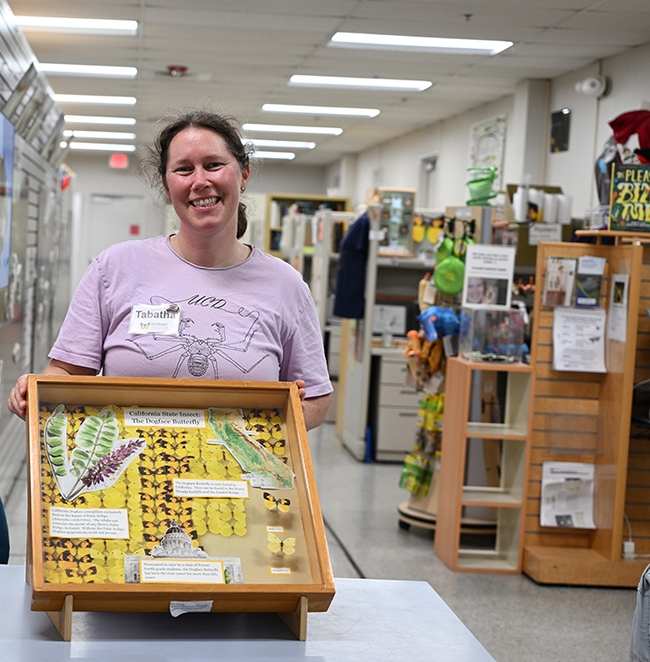
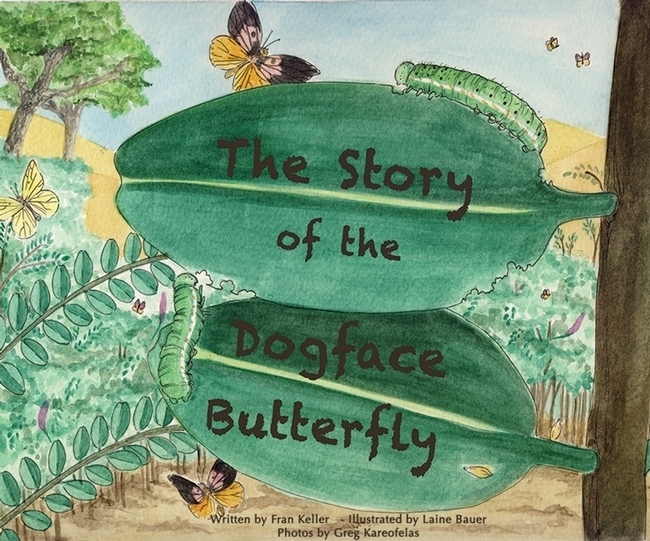
- Author: Kathy Keatley Garvey
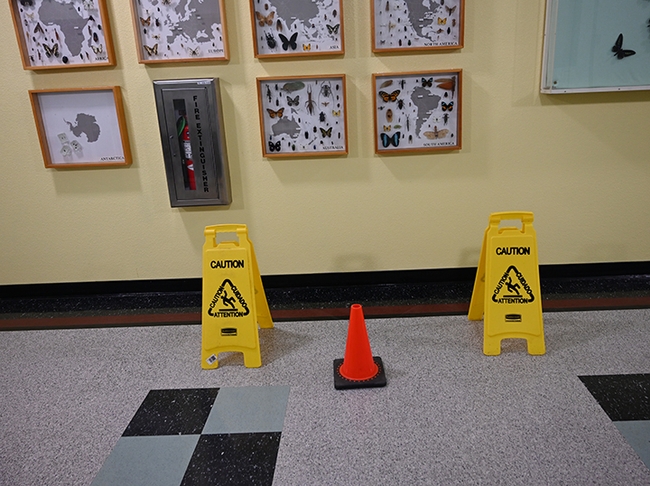
Then around 5:30 comes the urgent message from her colleague, arachnologist Jason Bond, associate dean of the UC Davis College of Agricultural and Natural Resources and the Evert and Marion Schlinger Endowed Chair of the Department of Entomology and Nematology. The Bond lab and the Bohart Museum share a portion of the first floor of the Academic Surge Building on Crocker Lane.
Lynn, there's a water leak at the Bohart Museum! Emergency!
Lynn hurries to her car and heads to the Bohart Museum. When she enters the building, there in the hallway is the "wet area," blocked with yellow "caution" floor signs and a bright orange pylon.
Except the "wet area" is dry. Bone dry.
Surprise! Surprise! Happy birthday!

Unbenownest to Kimsey, the UC Davis Entomology Club (advised by her husband, forensic entomologist Bob Kimsey, adjunct professor with the Department of Entomology and Nematology), had earlier decorated the museum with birthday balloons, banners and streamers.
Meanwhile, where is Bob? He had finished preparing taco fixings at their son's home for the birthday celebration and was heading toward the Yolo Causeway (connecting West Sacramento with Davis), when traffic delayed him.
Not to worry, Bob and the taco fixings made it.
Meanwhile, Lynn sets about opening a myriad of gifts, including a miniature hinged box from Keller ("Lynn likes tiny boxes," Keller said). Other gifts include an "Educated Guess" wine from Oakville, and a 10-inch radio-controlled tarantula, billed as "big, hairy and scary."
It wasn't. But with Lynn Kimsey at the controls, the tarantula races around the floor, stopping at feet that pretend to stomp it.
This was a milestone birthday celebration! (We're not telling which one, but Lynn Kimsey probably will!)
The "big, hairy and scary" radio-controlled tarantula is now sharing the Bohart Museum with several live tarantulas from its petting zoo:
- Princess Herbert, the Brazilian salmon-pink bird-eating tarantula (Lasiodora parahybana). She is estimated to be around 20 years old, the oldest current resident of the Bohart Museum
- Peaches, the Chilean rose hair tarantula (Grammostola rosea)
- Coco McFluffin, the Chaco golden knee tarantula (Grammostola pulchripes), native to Paraguay and Argentina
Kimsey and other Bohart Museum officials are now gearing up for the 12th annual UC Davis Biodiversity Museum Day, a Super Science Day, set Saturday, Feb. 18 when 11 museums or collections (including the Bohart) open their doors to the public. It's free and family friendly. (See line-up)
The Bohart Museum, founded in 1946, houses a global collection of eight million insect specimens, plus a petting zoo, featuring Madagascar hissing cockroaches, walking sticks and tarantulas; and a year-around gift shop, stocked with insect-themed books, posters, jewelry, t-shirts, hoodies and more. Named for UC Davis professor and noted entomologist Richard Bohart (1913-2007), the museum is dedicated to "understanding, documenting and communicating terrestrial arthropod diversity."
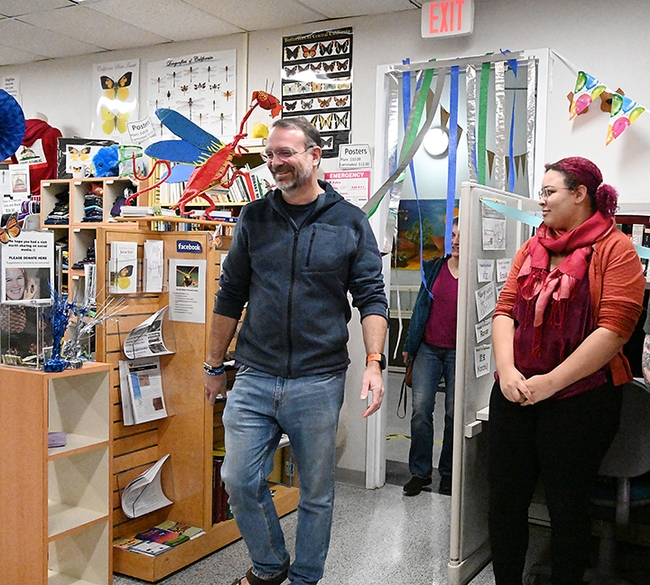
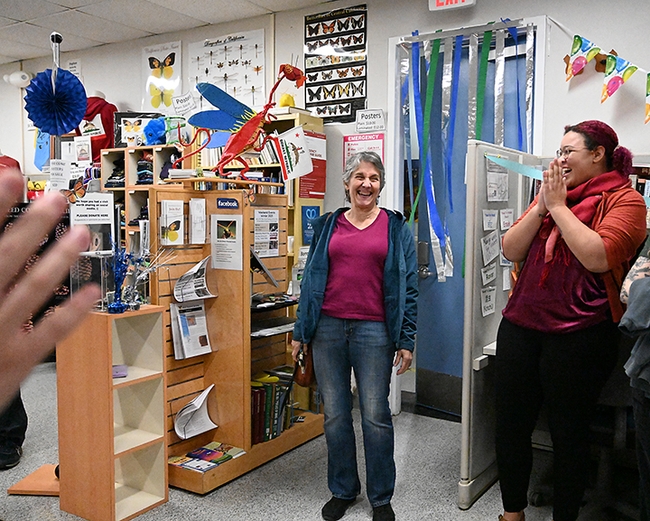
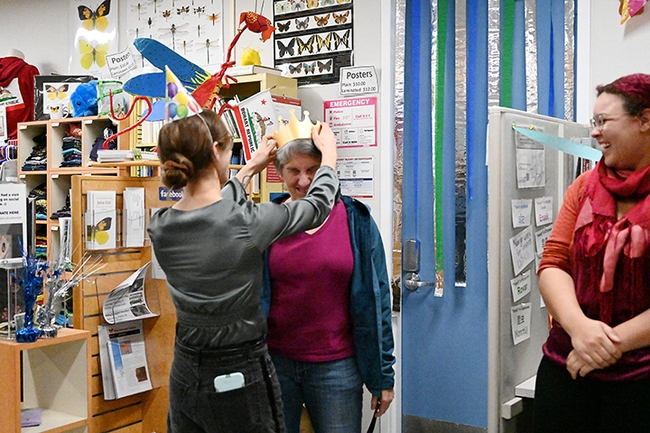

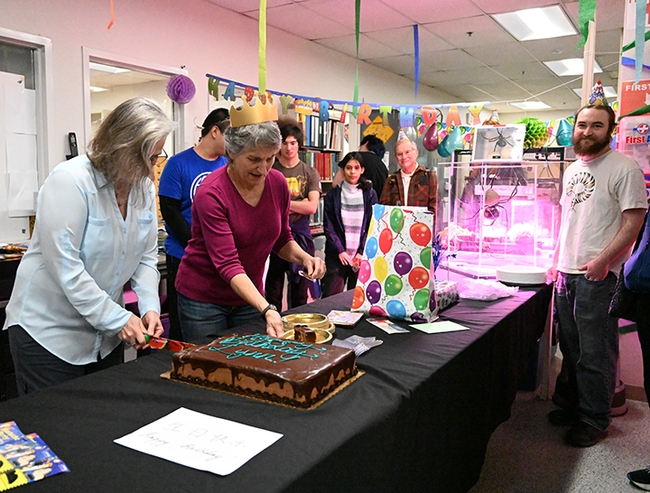
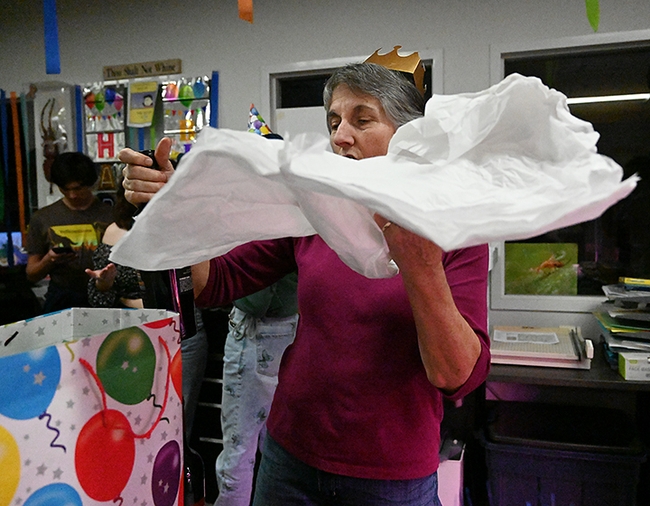
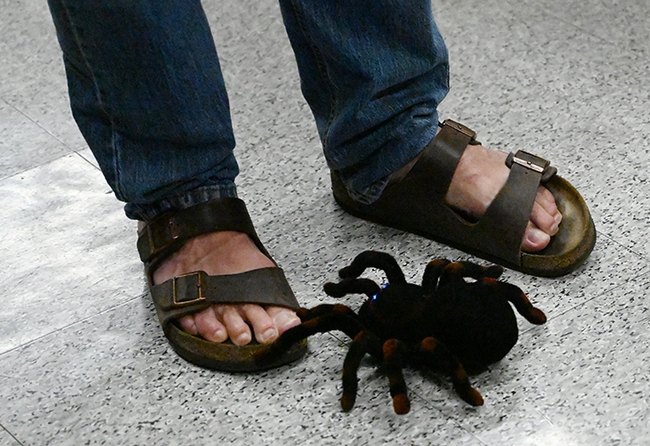
- Author: Kathy Keatley Garvey
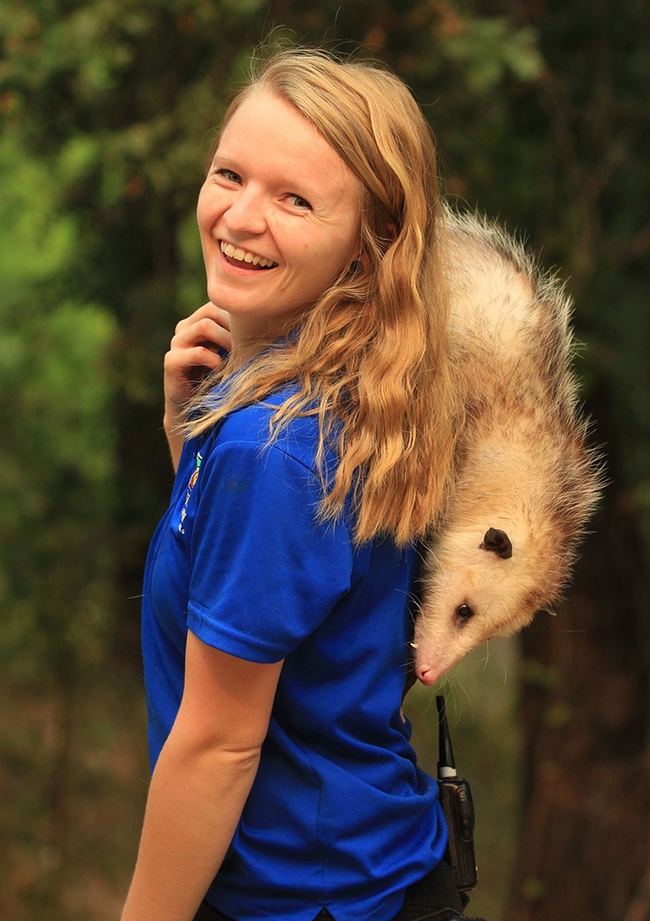
From boring beetles to burying beetles...and beetles from Belize and more...
And you're invited.
The Bohart Museum of Entomology is hosting an open house, themed "Beetles," from 1 to 4 p.m., Sunday, Jan. 24 in Room 1124 of the Academic Surge Building, 455 Crocker Lane, UC Davis campus. It's free and family friendly.
A Cal Fire display of bark beetle specimens; children's activities by Project Learning Tree California; and a UC Davis graduate student's display of tree cores and boring tools are among the new additions to the open house.
Also scheduled to participate is carabid beetle expert Kipling "Kip" Wills, associate professor with the UC Berkeley Department of Environmental Science, Policy and Management, announced Lynn Kimsey, director of the Bohart Museum and a UC Davis distinguished professor of entomology.
Cal Fire
Curtis Ewing, a senior environmental scientist with Cal Fire's Forest Entomology and Pathology, will show specimens of "many different invasive and native species that do or could impact forest health in California." They include such specimens as Ips engravers, Western pine beetles, flat-headed borers and various long-horned beetles. Among others on the list: coconut rhinoceros beetles, South American palm weevils, Asian longhorned beetles, emerald ash borers, gold spotted oak borers, Eucalyptus borers, invasive shot hole borers and Mediterranean oak borers.
"I will have a table with displays and a USB microscope hooked up to a screen and specimens," Ewing said, "so people can put different, small, species under the scope."
What should people know about bark beetles and the damage they cause?
"Native bark beetles, roundheaded borers and flatheaded borers are a natural part of our native forest ecosystems," Ewing said. "When our forests receive adequate amount of rain and do not suffer from extreme heat stress, these beetles thin the forest by attacking weakened and diseased trees. During times of high water stress, which is a combination of low rainfall, and often more importantly, high levels of heat stress, these native beetles can kill large forest areas. Trees in our cities and towns are threatened by a number of introduced beetles that attack and kill healthy trees. The beetles are able to attack trees that are otherwise healthy and happy, not suffering from drought or heat, because they lack an effective defense against these new alien."
Project Learning Tree California
Jonelle Mason, a UC Agriculture and Natural Resources (UC ANR) employee and coordinator of Project Learning Tree (PLT) California, an initiative of the Sustainable Forestry Initiative (partnered with the California Department of Forestry and Fire Protection-Urban and Community Forestry Program), will be tabling children's activities in the hallway of the Academic Surge Building. They will include a hands-on peppermint beetle activity.
"We specifically have an activity focused for K-5 called peppermint beetle!" Mason related. "It models how animals use a sense of smell to respond to the environment around them and identifying smells in our daily lives. "This is a super fun activity to present and then bring back to kids! It specifically will focus on bark beetles."
Mason, a master herpetologist and a former zookeeper with a bachelor's degree in biology, worked with exotic animals for 12 years before joining the PLT team to continue "my fierce love for nature and environmental education." As a zookeeper, she worked "with some of the largest animals on the planet" and "used animal training to influence thousands of people throughout the country."
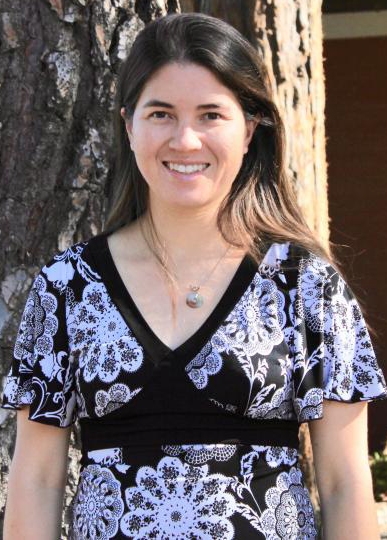
UC Davis graduate student Jennifer Cribbs of the Graduate Program of Environmental Policy and Management, will display tree cores and boring tools. She focuses on restoration, botany and forest dynamics. Cribbs holds a bachelor's degree in psychology from Stanford University. Following her graduation, she worked for the National Park Service, the U.S. Forest Service, and the U.S. Geological Survey where her job duties ranged from tagging endangered sea turtles at Padre Island National Seashore to leading a field crew focused on assessing the health of white pines in Sequoia and Kings Canyon National Park.
Previously announced:
Burying Beetles
Tracie Hayes, a doctoral candidate and burying beetle researcher in the laboratory of Professor Louie Yang, UC Davis Department of Entomology and Nematology, will discuss her work and present a video she created, "A Clearance of Death on Behalf of Life" at https://youtu.be/cGLOE7SrbiU. She will field questions about the insect and her research. (See news story)
Beetles from Belize
Folsom Lake College professor Fran Keller, a Bohart Museum scientist and a UC Davis doctoral alumna of entomology, will discuss the beetles that she and other scientists collected in Belize. (See Bug Squad blog)
Arts and Crafts
The family arts-and-craft activity will be to color a drawing of a carrion beetle, the work of Tracie Hayes.
The Bohart Museum, dedicated to "understanding, documenting and communicating terrestrial arthropod diversity," was founded in 1946 and named for UC Davis professor and noted entomologist Richard Bohart. In addition to its global collection of eight million insect specimens, it houses a live "petting zoo," featuring Madagascar hissing cockroaches, walking sticks and tarantulas; and a year-around gift shop, stocked with insect-themed books, posters, jewelry, t-shirts, hoodies and more.
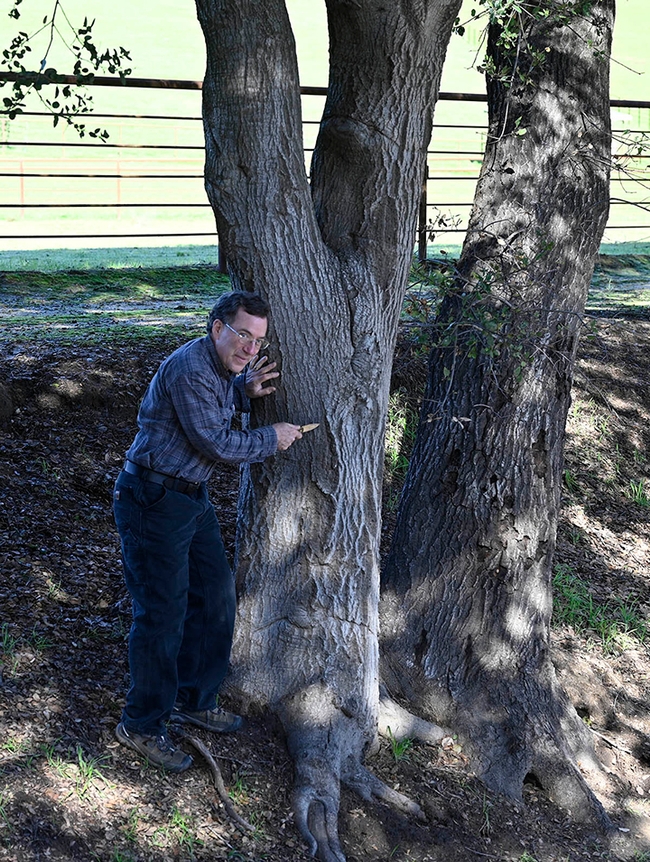
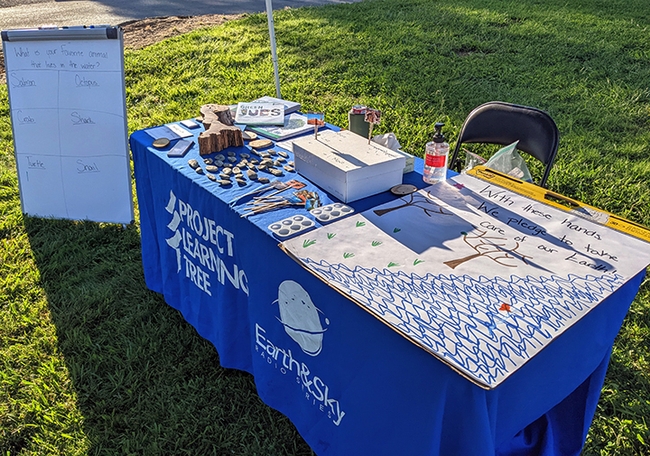
- Author: Kathy Keatley Garvey
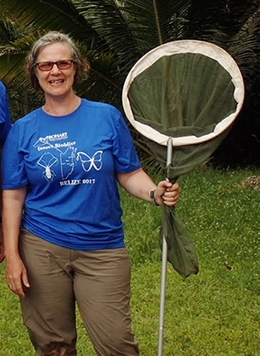
The Bohart Museum of Entomology open house on beetles, set Sunday, Jan. 22, will include "Beetles in Belize."
Beetle expert Fran Keller, a professor at Folsom Lake College and a Bohart Museum scientist, will discuss the beetles that she and other scientists collected in Belize, and will introduce the public to several drawers of the specimens.
The open house will take place from 1 to 4 p.m. in Room 1124 of the Academic Surge Building, 455 Crocker Lane, UC Davis campus. It is free and family friendly.
"In November I started working in the Natural History Museum London Coleoptera collection, working on Belize Cerambycidae to facilitate identification and then catalog specimens for the Belize National Insect Collection," Keller said. "I worked with Larry Bezark, via the internet/email/Google Drive, who is retired from the California Department of Food and Agriculture. There were 28 new country records for Belize and two new species to science that Larry will describe."
"We don't have an exact number but I would say we have over 500 beetle species identified, but there are many more that need identification."
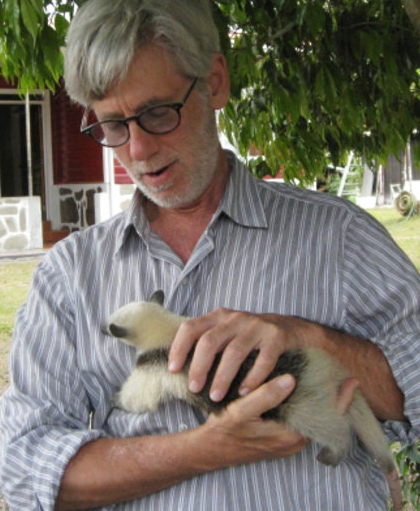
Among the other presenters at the Bohart Museum open house will be UC Davis graduate student and burying beetle researcher Tracie Hayes of the laboratory of Professor Louie Yang, UC Davis Department of Entomology and Nematology; and Cal Fire bark beetle specialist Curtis Ewing, a senior environmental scientist, Forest Entomology and Pathology.
The family arts-and-crafts activity will be to color a drawing of a carrion beetle, the work of Tracie Hayes.
The Bohart Museum, directed by Lynn Kimsey, UC Davis distinguished professor of entomology, Department of Entomology and Nematology, houses a global collection of eight million insect specimens; a live "petting zoo" that includes Madagascar hissing cockroaches, stick insects, cave roaches, tarantulas, black widow spiders, a brown widow spider and a centipede (see species); and a year-around gift shop, stocked with insect-themed t-shirts, hoodies, jewelry, books, posters and collecting equipment.
Founded in 1946, the Bohart Museum is named for noted entomologist Richard Bohart (1913-2007), UC Davis entomology professor, and is open to the public from 8 a.m. to noon, and 1 to 5 p.m., Mondays through Thursdays.
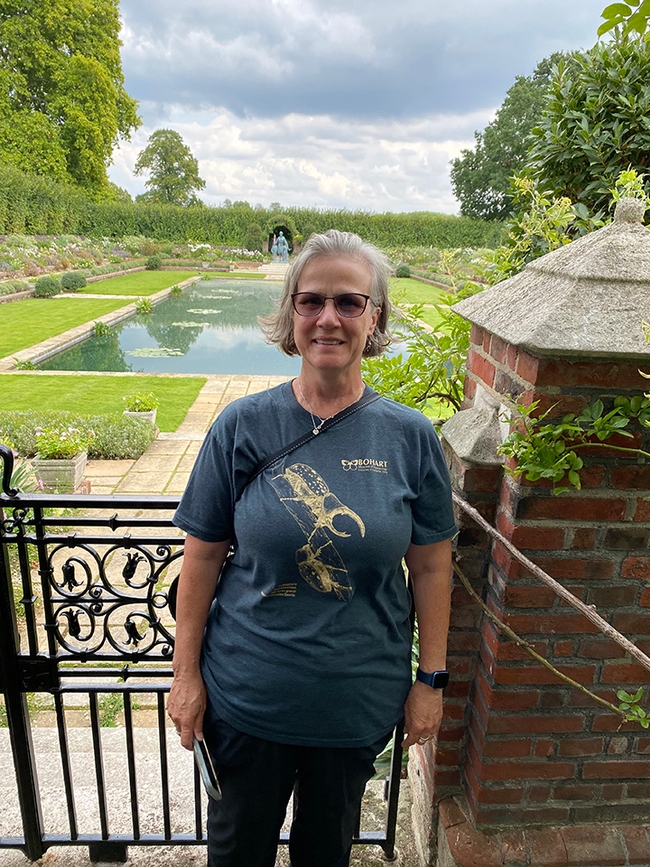
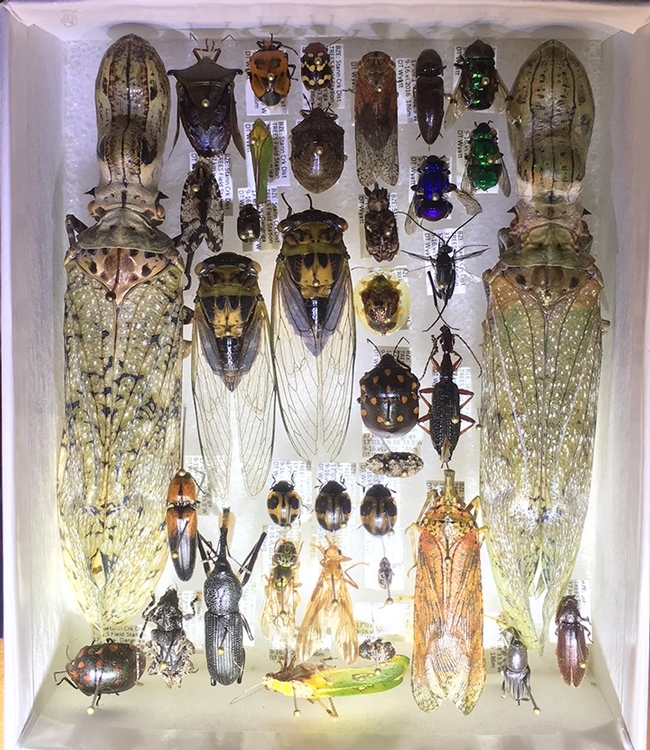
- Author: Kathy Keatley Garvey
If you're planning to visit the Bohart Museum of Entomology on the University of Davis, campus, the hours are limited during the holiday season.
Tabatha Yang, education and outreach coordinator, announced today:
- The last day in December that we are open to the public is Thursday, Dec. 15 from 9 a.m. to noon, and 1-5 pm.
- On Friday, Dec. 16 we are here working, but are closed to the public. Researchers and staff are welcome at the Bohart to do research or to shop. You may need to knock on the door, though.
- Next week Monday, Dec. 19 through Thursday, Dec. 22 we will be here for research and will be answering phones, emails and can coordinate in-store pick-ups for anyone who shops on-line https://www.
bohartmuseumstore.com/. (Email us if you are planning to stop by. Our hours are typically 9-moon and 1-5 pm. Researchers and staff can shop in store at this time.) - From Friday, Dec. 23- Monday, Jan. 2 the museum will be closed. We will all be on holiday and/or working from home, so no one will be answering the Bohart phones or be available for in-store pick-ups.
- We will re-open as usual on Tuesday, January 3.
The Bohart Museum, home of a global collection of eight million insect specimens, a live "petting zoo" and a gift shop, is located in Room 1124 of the Academic Surge Building, 455 Crocker Lane. Admission is free.
Founded in 1946, the Bohart is directed by Lynn Kimsey, UC Davis distinguished professor of entomology. It is named for UC Davis professor and noted entomologist Richard Bohart, who was Kimsey's major professor. Weekend open houses are held periodically throughout the year. The Bohart is one of the co-founders and co-leaders of the campuswide Biodiversity Museum Day, traditionally held on President's Weekend (details to be announced soon) and UC Davis Picnic Day. The 109th annual Picnic Day, which draws some 75,000 visitors to the campus, will be Saturday, April 15.
